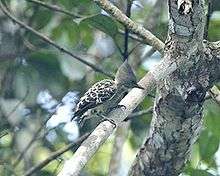Grey-and-buff woodpecker
| Grey-and-buff woodpecker | |
|---|---|
 | |
| Female with grey forehead | |
| Scientific classification | |
| Kingdom: | Animalia |
| Phylum: | Chordata |
| Class: | Aves |
| Order: | Piciformes |
| Family: | Picidae |
| Genus: | Hemicircus |
| Species: | H. sordidus |
| Binomial name | |
| Hemicircus sordidus (Temminck, 1821) | |
The grey-and-buff woodpecker (Hemicircus sordidus) is a species of bird in the family Picidae. It is found in Brunei, Indonesia (Sumatra and Borneo), Malaysia, southern Myanmar, and southern Thailand, but has become regionally extinct in Singapore. Its natural habitats are lowland and montane tropical or subtropical moist broadleaf forests.
Description
The species has a plump body and short rounded tail, and grows to a length of about 13.5 cm (5.3 in). The head appears large because of the slender neck and the large, cone-shaped crest. The head is largely grey, with a fine white, wavy line running from the cheek to the mantle. In males the forehead is red and the crest grey, while in females, both are grey. Body upper parts and wings are blackish, the feathers being edged with white or buff giving a scalloped effect. Underparts are grey, the tail and underwing dark, and the legs are grey or brown. The beak is long, slender and grey with a black tip, and the iris is chestnut. A gland of unknown function is on the back, the secretions from which sometimes stain the white rump.[2]
Distribution and habitat
This woodpecker is native to tropical southeastern Asia. Its range extends from southern Myanmar and peninsular Thailand and Malaysia, to Sumatra and Borneo. It is a resident species found in lowland and mid-elevation evergreen rainforests, particularly clearings and forest edges, also in plantations, bamboo thickets, cleared areas, wooded urban areas and cultivated land.[2]
Ecology
The grey-and-buff woodpecker is usually seen singly or in pairs, but sometimes occurs in mixed species flocks foraging in the canopy. It mainly feeds by gleaning rather than by drilling into the wood, the diet consisting of insects and fruit, including mistletoe (Loranthus) berries.[3] The birds roost communally at night in shallow holes they excavate near each other in dead wood.[2] Nesting takes place in deeper holes or crevices, the breeding season being between December and July.[3]
Status
Although H. sordidus occurs in a range of habitats, numbers are thought to be in gradual decline through loss of habitat, and it has become locally extinct in Singapore. It has a very large range and is generally described as being uncommon.[1] The International Union for Conservation of Nature has assessed its conservation status as being of "least concern".[1]
References
- 1 2 3 BirdLife International (2016). "Hemicircus sordidus". The IUCN Red List of Threatened Species. IUCN. 2016: e.T22727220A94943980. doi:10.2305/IUCN.UK.2016-3.RLTS.T22727220A94943980.en. Retrieved 14 January 2018.
- 1 2 3 Gorman, Gerard (2014). Woodpeckers of the World: A Photographic Guide. Firefly Books. pp. 97–99. ISBN 177085309X.
- 1 2 del Hoyo, J.; Collar, N.; Christie, D.A. "Grey-and-buff Woodpecker (Hemicircus sordidus)". Handbook of the Birds of the World Alive. Lynx Edicions, Barcelona. Retrieved 6 April 2017.
